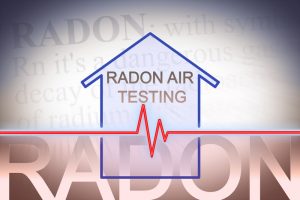 No matter where you are, if you turn on a Geiger counter, you’re going to hear a steady but infrequent pattern of clicks. This is termed background radiation and is completely normal. It is what’s found in the environment and comes from natural sources like cosmic radiation and naturally occurring materials such as radium or radon.
No matter where you are, if you turn on a Geiger counter, you’re going to hear a steady but infrequent pattern of clicks. This is termed background radiation and is completely normal. It is what’s found in the environment and comes from natural sources like cosmic radiation and naturally occurring materials such as radium or radon.
Rocks such as limestone, granite, and shale degrade slowly over time, releasing naturally-occurring radiation such as radon. It’s when radon levels exceed norms that you have a problem that needs attention.
What Causes Spikes in Radon Levels?
Airborne radon is colorless and odorless, and can infiltrate a home through gaps around windows and doors, poorly-sealed pipes entering the foundation, exterior vents and even water (primarily well water). It’s estimated that one in 15 homes has an abnormally high level of radon, and radon problems seem to be concentrated in the Midwest, northern plains, southern Appalachia and the Northeast.
While radon is naturally-occurring outdoors, it can be concentrated in homes, especially a stuffy home that’s poorly-ventilated. It’s believed that radon concentrations are more prevalent near mining areas and quarries, after researchers found elevated numbers of radon-related cancers in miners.
Why Is Radon Dangerous?
Radon is second only to cigarettes when it comes to causing lung cancer. It’s believed that 21,000 Americans die from radon-related cases of lung cancer yearly, according to the EPA. In other words, it’s the leading cause of lung cancer among non-smokers.
Radon mitigation is important if elevated levels of radon have been detected in your home. Radon detection kits are available for homeowners – the detector should be placed in the lowest level of a home for two to seven days, then sent off to a laboratory for analysis. Longer-term kits that take readings for up to 90 days are also available.
Methods for mitigating and reducing radon levels include:
- Vent pipe and fan, pulling radon from a home’s crawlspace or basement and venting to outside air, aka sub-slab depressurization, active soil depressurization or soil suction
- Laying down a high-density plastic sheet on the soil in homes with crawlspaces, then using a vent pipe and fan under the sheet to vent radon to outdoor air
- Using a blower to vent interior air from ductwork and behind drywall to outdoor air
- Keeping indoor humidity levels down
- Using granular activated charcoal or aeration methods to treat water supplies from wells and dissipate radon levels
Radon in indoor air was discovered almost by accident in the 1980s – and has since been considered a prime threat to indoor air quality. The good news is that radon detection and mitigation methods are pretty well-researched and well-established. Whether you think your home has a radon issue or not, it’s worth buying a test kit and finding out for sure, if only for your own peace of mind.
There’s nothing to lose from knowing, especially when your own health might be on the line. Contact The Clean Air Act for radon testing and mitigation in Portland, OR today!
